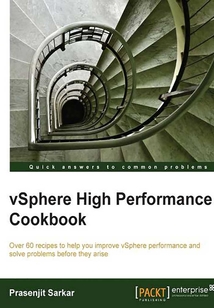舉報 

會員
vSphere High Performance Cookbook
最新章節:
Index
vSphereHighPerformanceCookbookiswritteninapractical,helpfulstylewithnumerousrecipesfocusingonansweringandprovidingsolutionstocommon,andnot-socommon,performanceissuesandproblems.ThebookisprimarilywrittenfortechnicalprofessionalswithsystemadministrationskillsandsomeVMwareexperiencewhowishtolearnaboutadvancedoptimizationandtheconfigurationfeaturesandfunctionsforvSphere5.1.
目錄(91章)
倒序
- 封面
- 版權信息
- Credits
- About the Author
- About the Reviewers
- www.PacktPub.com
- Preface
- Chapter 1. CPU Performance Design
- Introduction
- Critical performance consideration – VMM scheduler
- CPU scheduler – processor topology/cache aware
- Ready time – warning sign
- Hyperthreaded core sharing
- Spotting CPU overcommitment
- Fighting guest CPU saturation in SMP VMs
- Controlling CPU resources using resource settings
- What is most important to monitor in CPU performance
- CPU performance best practices
- Chapter 2. Memory Performance Design
- Introduction
- Virtual memory reclamation techniques
- Monitoring host-swapping activity
- Monitoring host-ballooning activity
- Keeping memory free for VMkernel
- Key memory performance metrics to monitor
- What metrics not to use
- Identifying when memory is the problem
- Analyzing host and VM memory
- Memory performance best practices
- Chapter 3. Networking Performance Design
- Introduction
- Designing a network for load balancing and failover for vSphere Standard Switch
- Designing a network for load balancing and failover for vSphere Distributed Switch
- What to know when offloading checksum
- Selecting the correct virtual network adapter
- Improving performance through VMDirectPath I/O
- Improving performance through NetQueue
- Improving network performance using the SplitRx mode for multicast traffic
- Designing a multi-NIC vMotion
- Improving network performance using network I/O control
- Monitoring network capacity and performance matrix
- Chapter 4. DRS SDRS and Resource Control Design
- Introduction
- Using DRS algorithm guidelines
- Using resource pool guidelines
- Avoiding using resource pool as folder structure
- Choosing the best SIOC latency threshold
- Using storage capability and profile driven storage
- Anti-affinity rules in the SDRS cluster
- Avoiding the use of SDRS I/O Metric and array-based automatic tiering together
- Using VMware SIOC and array-based automatic tiering together
- Chapter 5. vSphere Cluster Design
- Introduction
- Trade-off factors while designing scale up and scale out clusters
- Using VM Monitoring
- vSphere Fault Tolerance design and its impact
- DPM and its impact
- Choosing the reserved cluster failover capacity
- Rightly choosing the vSphere HA cluster size
- Chapter 6. Storage Performance Design
- Introduction
- Designing the host for a highly available and high-performing storage
- Designing a highly available and high-performance iSCSI SAN
- Designing a highly available and high-performing FC storage
- Performance impact of queuing on the storage array and host
- Factors that affect storage performance
- Using VAAI to boost storage performance
- Selecting the right VM disk type
- Monitoring command queuing
- Identifying a severely overloaded storage
- Chapter 7. Designing vCenter and vCenter Database for Best Performance
- Introduction
- vCenter Single Sign-On and its database preparation
- vCenter Single Sign-On and its deployment
- Things to bear in mind while designing the vCenter platform
- Designing vCenter Server for redundancy
- Designing a highly available vCenter database
- vCenter database size and location affects performance
- Considering vCenter Server Certificates to minimize security threats
- Designing vCenter Server for Auto Deploy
- Chapter 8. Virtual Machine and Application Performance Design
- Introduction
- Setting the right time in Guest OS
- vNUMA (Virtual NUMA) considerations
- Choosing the SCSI controller for storage
- Impact of VM swap file placement
- Using large pages in virtual machines
- Guest OS networking considerations
- When you should or should not virtualize an application
- Measuring the application's performance
- Index 更新時間:2021-08-13 16:23:16
推薦閱讀
- 程序員面試白皮書
- 微信公眾平臺與小程序開發:從零搭建整套系統
- 計算機圖形學編程(使用OpenGL和C++)(第2版)
- PostgreSQL Cookbook
- Magento 2 Theme Design(Second Edition)
- Python機器學習經典實例
- Mastering Linux Security and Hardening
- Python圖形化編程(微課版)
- Hadoop大數據分析技術
- Learning Android Application Testing
- 嵌入式Linux C語言程序設計基礎教程
- Kotlin進階實戰
- MATLAB 2020 GUI程序設計從入門到精通
- Java自然語言處理(原書第2版)
- Spring Boot 3:入門與應用實戰
- 數據庫基礎與應用實驗教程:Visual FoxPro 6.0
- Python程序設計教程
- 深度學習企業實戰:基于R語言
- Tableau數據可視化從入門到精通
- 計算機網絡基礎
- R語言數據處理及可視化分析
- 前端程序員面試筆試真題庫
- SysML精粹
- C++項目開發全程實錄(第2版)
- 西游趣味造物記
- Python基礎編程入門
- Mastering Hibernate
- Elasticsearch Indexing
- 圖解CSS3:核心技術與案例實戰
- 零基礎學Struts

